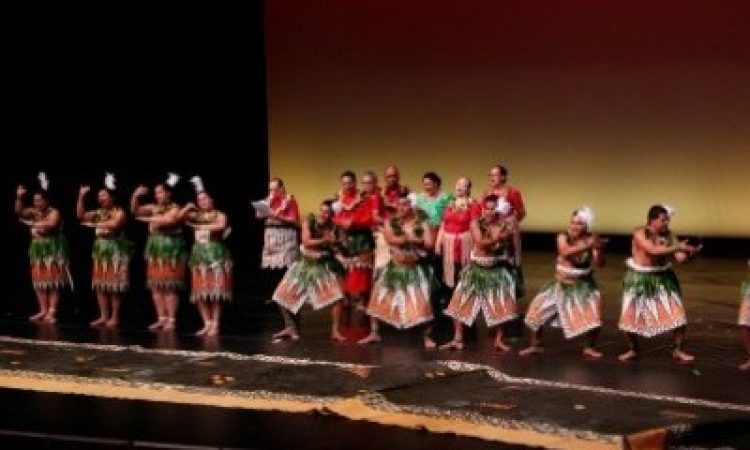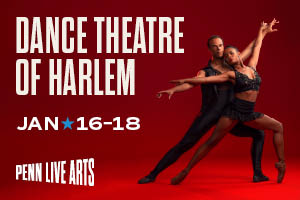Honolulu—Let’s begin at the show’s end. Maelia Loebenstein Carter, a ‘kumu hula’ (master teacher of Hawaiian dances, half-artist, half-religious leader), is left alone onstage, her dancers having just made a graceful exit. Her head’s ringed in a ti leaf lei, her body wrapped in bright yellow. She sounds one sharp slap on her gourd drum and onstage bounds Woo Kwang Hyuk, a Korean musician-prankster who, with a small gong, rings out a rhythmic pulse.
One by one the groups who’ve danced during the evening enter—first the Hawaiian women in billowy cotton, red and yellow, with leis ringing their heads, necks, wrists, and ankles. They glide as much as step, their feet padding gently as they slip from one side to the other, hips swaying as their hands form evanescent gestures. Then they bow. Then the Koreans, some in elaborate court dress and others in multicolored t-shirts and pants, step in simply, a snapshot of past and present.
The Tongans are draped with leis too, white ginger root flowers on several, and all are wrapped with stiff ornamented mats pounded from the bark of the mulberry tree, bound at their waists. With their entrance, the whole stage and audience erupt with unbridled joy, the young Korean men busting out their K-pop moves, and older Tongans waving their arms high as they dance in pleasure.
Ike Hana is the umbrella name for this concert, one of two evenings of old and new dances from the three resident groups of the fourth bi-annual Asia Pacific Dance Festival, held at the University of Hawaii at Manoa. In Hawaiian “Ike Hana” means “to see, to experience, to think.” Over the course of those evenings, we could see dances of the past faithfully preserved alongside dances of today that incorporate traditional elements. We could experience the joy and sense of community fostered by dances serene and celestial, or rowdy and stirring. We could think about the place of dance in culture—how it has the power to create cohesion and a sense of belonging, to uplift; how it has the power to transcend boundaries and create understanding between people of different cultures. Ike Hana was a mash-up of 28 dances by groups from Korea, Tonga and Hawaii—a feast of dance from the Asia Pacific region.
Masterpiece of Oral and Intangible Humanity
Tongans from the village of Kanokupolu dance a different version of their Lakalaka each night. Lakalaka is the only dance of Pacific Islanders that’s been named a Masterpiece of Oral and Intangible Humanity by UNESCO. One can feel not only the Kanokupolans’ pride and pleasure in performing it, but also the stirring effect it has on Tongan audience members who shout or clap or even dance in their seats.
Arrayed in a line across the stage, six men dance on the right, five women on the left, with plumes of white feathers extending upward from their hair. The musicians behind them sing the Lakalaka’s short, repeating song sweetly, accompanied by a drum. A program note states that one night’s lyrics honor Kanokupolu and its chiefs, and the second night’s lyrics add allusions to the kava ceremony and to a beach where missionaries landed. With their knees always close together and steps small, the women’s part unspools with hands shaping the words of the song lyrics and subtle tilts and facings of the head. The men soften their knees and splay their legs wide, slapping their knees and clapping sharply. Sometimes they hunker, sometimes lurch, enjoying the fullness and power of their amplified gestures. By the dance’s end, the singing rings out, some voices high, some booming and low, and the dancers have dialed up their intensity.

Program notes detail the themes addressed in the other Tongan dances: one tells of the feats of gods and chiefs, another of traveling by canoe, others of visitors from other islands, and features of the Tongans’ land. There are dances to prepare the space at the beginning, performed seated with a recurring sweeping motion, and others to celebrate the beauty of the Tongan women.
For each dance there’s a costume change, mostly a wrapping of the stiff tapa cloth, stamped with geometric patterns. Some tapas are all earth tones, others are nearly black and white with zingy zig zags. The musicians behind the dancers wear bright shirts, all in the same vibrant red, and wrap a mat or ornamental grass around their waists as a sign of respect.
Before dancing, Tongans smear oil on their skin for what they consider an attractive shininess. So when audience members come to them mid-performance offering dollar bills, as is customary, the bills can be tucked into a bodice or waist band, or stuck to the dancer’s skin.
I love watching the faces of the Tongans. As they dance their pleasure mounts. The women are subtly joyous, never calling attention to themselves, but clearly relishing the flourishes of their intricate rotations of wrists and shaping of fingers. The men’s energetic commitment increases as each dance goes along. They don’t just perform actions, they throw the full weight of their being into them, thrusting as if that imagined spear was at a boundary between life and death. And many Tongans in the house reflect their joy, dancing in their seats or shouting “mâlie!” which translates as “bravo, splendid!”
Gentle Waters and Old Truths
Like the Tongan dances, each hula presented in Ike Hana takes a chanted poem as its basis. The Ike Hana selections include a procreation chant, which typically closes a performance, a chant relating the Hawaiian origin story, and various tales of lovers. Others honor the elements, the land, and gods and goddesses—Pele, goddess of fire, lava, and the birth of new land; and Laka, the goddess of hula.
With their language foreign to me, I read distinct moods in these hulas. Most often the groups of female dancers in long swingy skirts, blousy tops, and a variety of leis, wear expressions of tenderness, as though they are sending their deepest wishes to faraway places. They form the language of their hands softly, reaching their hands upwards for instance, then delicately drawing them down, fingers trembling, for “rain.” Their hips steadily churn side to side or with a rounder backward sweep. It’s as if their lower bodies were carrying them across gentle waters while their upper bodies are speaking old truths. Several of the dances end, after multiple verses with repeating gestures, by shifting the plane of action from side/side to forward and back, moving to or away from the audience, a clear punctuation.

The dancers speak the beginning words of each new stanza, a shared cueing system it seems, giving the dancers actual voice to go with their fluid and supple physicality. The embodiment of hula communicates what’s called the “aloha spirit”—a gentle, kind, and welcoming way of being. One senses that these modern-day women remain connected to their deep traditions and the sanity of their traditional culture by telling the old stories through their bodies.
The programs list both ancient, “kahiko,” and modern, “auwana,” hulas. One modern piece, Mele Ho’āla Moku (2017) by Carter is compelling accumulation, hula-style, with three sets of three or four dancers, each with a different instrument. Seated in a downstage corner, singers tap and pound their gourds as percussion. A second grouping places itself across the space, layering the sounds of striking sticks together. A third set of dancers take center stage, clicking their ‘ili’ili stones like castanets, completing the percussive tapestry. Here, as in many of the hulas, and other Ike Hana dances too, soft, sinuous movement contrasts with the sharp sounds of percussion or piercing woodwinds.
A Nightingale and a Rousing Buffoon
Performers from K’Arts, as Korea National University of Arts is known, show a range of Korean forms from stately classical court dance to a bounding, playful example from the masked dance-drama tradition, to what are termed “creative” and “contemporary” dance, melding Western and Korean moves.

In Ch’unaengjon (Nightingale in Spring) the Korean dancer Eunyoung Park and the four dancers flanking her wear traditional high-waisted gowns in extravagant primary colors with extended sleeves. In this Korean court dance they step in slower-than-slow motion, so subtly breathing together as they walk or raise their arms that the dance is a lesson in the strength of near-stillness. The shrill woodwind and drum accompaniment only makes the movement seem more sublimely expansive.
Changyeol Heo, a Korean masked dancer, lopes around the stage like a buoyant rubber ball in Tötbaegi Ch’um, done traditionally without a mask. His smile ever-wide, his knees marshmallow spongy, and body with just a touch of rag doll floppiness, he repeats a dramatic leap ending into a deep-planted lunge. The energy of this dance, beginning with its first line of text cried out, and sharp thwack on the drum, rouses the spirit. At its conclusion the audience responds with roaring applause.

Two recent group choreographies from Korea were also among the audience favorites. Moonae Choi based her Composition 17 (2016) on a Kandinsky painting that seems a natural movement score with its colorful arcs, lines, and planes. Snapping open large fans in a rainbow of colors, the dancers, with swift shuffling steps, slipped into a range of stage pictures, with their open fans as punctuation marks at varying heights and angles. One after another tableaux were configured and reconfigured, often with one dancer left moving as the others provided a vibrant, living “set” in their stillness. Unison seemed the exception for these dancers, whose individualized trajectories and movement sequences lifted off, literally: leaping, bouncing, and tumbling into the floor. This offered a reminder that much contemporary dance forgoes the unison that’s near-universal in the traditional forms presented here, where dancers all face the same direction, are equidistant, and perform the same movement at the same time.

Samyim Kim’s Ch’uichöng (Going into Battle in Daily Life) opened with a fight-like sequence, then toggled between sending the five dancers on their own paths and drawing them back to shared actions. With a palette of light gray/straw/white costumes and saturated blues in the backdrop, delicacy and strength combined in solos showcasing Sufi-like spinning, baroque arm calligraphies, expansive swings, and barrel turns. Accompanied with a traditional gong and voice, the finale, after the tumult calms, left the group huddled, soberly walking forward.
At the close of the second evening’s show, the Tongans sang in their full-voiced harmonies. The other performers came forward for their acknowledgement, then in two elegant snaking lines, the whole assembly processed offstage, waving their arms overhead. Two of the older Tongan women lingered, drinking in some of the applause just for themselves before slipping offstage and leaving an emptiness where so much heart and spirit had been.
.
‘Ike Hana I & II, Ka Pā Hula o Kauanoe o Wa’ahila (Hawaii), Kanokupolu Dancers (Tonga), Korea National University of Arts (K’Arts), August 5 & 6, Asia Pacific Dance Festival, Honolulu. http://manoa.hawaii.edu/outreach/asiapacificdance/
All photos by Maseeh Ganjali






